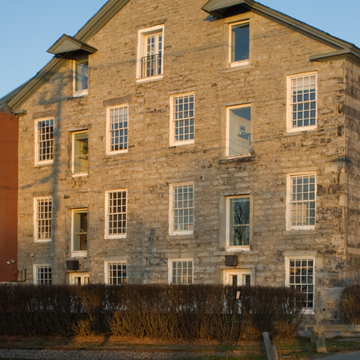An important building in the commercial history of Burlington, this stone structure was originally built as a warehouse for the cargo transfer and dockage firm of Mayo Follett. The nucleus of a bustling lake port commercial area, the building served the booming shipping trade spurred by the opening of the Champlain Branch (1823), Erie (1825), and Richelieu (1831) canals. Around 1841, the warehouse was expanded to the south with Greek Revival piers across its first-floor front and covered by a unifying roof with a cusped-arch window in the front pediment.
Bulk goods arriving at an adjacent man-made harbor (filled in when the railroad eclipsed the lake trade) were off-loaded and raised by block and tackle from two cantilevered hoisting arms (protected by gable hoods visible on the building's lake side) to loading bays at each floor level. Similar late Federal and Greek Revival canal-related structures exist in Vergennes, Orwell, and Shoreham, as well as in canal port towns in New York State.


















